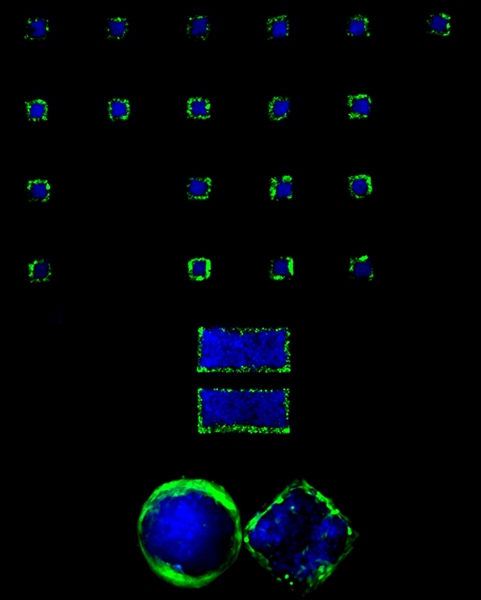Living systems are made of complex architectural organization of various cell types in defined microenvironments. The intricate interactions between different cell types control the specific functions of the associated tissues, such as the functions of native liver and cardiac tissues, metastasis and invasion of tumors, and embryonic development.
Replicating these complex associations could be useful for fabricating healthy tissues for regenerative medicine; diseased tissues, such as tumors, for drug discovery; models to study embryonic development; and models to study tissue morphogenesis. However, it has remained a challenge to control the targeted spatial organization of multiple cell types in defined microenvironments by using previous methods.
MIT researchers have developed a new versatile technique to control spatial distribution of multiple cell types in predefined 3-D geometries which was described in a paper published online Sept. 3 in Advanced Materials. They fabricated dynamic microstructures from a thermoresponsive polymer. These microstructures responded to temperature by changing their shape. MIT researchers exploited the temperature dependent shape changing characteristic of dynamic microstructures to seed different cell types at different temperatures. Spatial organization of multiple cell types was obtained in square and circular geometries.
Halil Tekin, the leading author of the paper, is a graduate student in electrical engineering and computer science at MIT. MIT undergraduate students Jefferson Sanchez ’13, Christian Landeros '14 and Karen Dubbin ’12 are other authors of the paper. Senior authors of the paper are Ali Khademhosseini, associate professor in the Harvard-MIT Health Sciences and Technology; and Robert Langer, the David H. Koch Institute professor at MIT. Undergraduate students Tonia Tsinman ’13 and Brianna Jones '14 also have contributed to the research during the early development of dynamic microstructures.
Different geometries can be obtained by using molds with different shapes. One could use these dynamic microstructures to replicate a microscale lobule of a human liver or microscale human cardiac tissues by using the associated cell types. These biomimetic tissues could be highly useful to test drug candidates without requiring the animal experiments which take more time and investment. Tissues mimicking the native tissues could also be implanted to human body.
Another application could be to recapitulate the tumor microenvironments. Various cell types associated with particular tumors could be spatially organized by using dynamic microstructures. The tumor models mimicking the native ones can be highly beneficial for drug discovery. The intricate interactions between various cell types regulating cell-signaling circuitry in a tumor microenvironment can be investigated by employing the dynamic microstructures.
MIT researchers also propose that these dynamic microstructures may potentially be useful to study embryonic development. Previous methods lacked mimicking dynamically changing geometry of embryo and controlling the spatial distribution of various cell types. The underlying mechanisms of early developmental stages could be studied by patterning associated cell types in various geometries. In the future, it would also be possible to fabricate microstructures changing their shapes by sensing the secreted proteins from the cells, which could be employed to replicate the embryonic development.
Replicating these complex associations could be useful for fabricating healthy tissues for regenerative medicine; diseased tissues, such as tumors, for drug discovery; models to study embryonic development; and models to study tissue morphogenesis. However, it has remained a challenge to control the targeted spatial organization of multiple cell types in defined microenvironments by using previous methods.
MIT researchers have developed a new versatile technique to control spatial distribution of multiple cell types in predefined 3-D geometries which was described in a paper published online Sept. 3 in Advanced Materials. They fabricated dynamic microstructures from a thermoresponsive polymer. These microstructures responded to temperature by changing their shape. MIT researchers exploited the temperature dependent shape changing characteristic of dynamic microstructures to seed different cell types at different temperatures. Spatial organization of multiple cell types was obtained in square and circular geometries.
Halil Tekin, the leading author of the paper, is a graduate student in electrical engineering and computer science at MIT. MIT undergraduate students Jefferson Sanchez ’13, Christian Landeros '14 and Karen Dubbin ’12 are other authors of the paper. Senior authors of the paper are Ali Khademhosseini, associate professor in the Harvard-MIT Health Sciences and Technology; and Robert Langer, the David H. Koch Institute professor at MIT. Undergraduate students Tonia Tsinman ’13 and Brianna Jones '14 also have contributed to the research during the early development of dynamic microstructures.
Different geometries can be obtained by using molds with different shapes. One could use these dynamic microstructures to replicate a microscale lobule of a human liver or microscale human cardiac tissues by using the associated cell types. These biomimetic tissues could be highly useful to test drug candidates without requiring the animal experiments which take more time and investment. Tissues mimicking the native tissues could also be implanted to human body.
Another application could be to recapitulate the tumor microenvironments. Various cell types associated with particular tumors could be spatially organized by using dynamic microstructures. The tumor models mimicking the native ones can be highly beneficial for drug discovery. The intricate interactions between various cell types regulating cell-signaling circuitry in a tumor microenvironment can be investigated by employing the dynamic microstructures.
MIT researchers also propose that these dynamic microstructures may potentially be useful to study embryonic development. Previous methods lacked mimicking dynamically changing geometry of embryo and controlling the spatial distribution of various cell types. The underlying mechanisms of early developmental stages could be studied by patterning associated cell types in various geometries. In the future, it would also be possible to fabricate microstructures changing their shapes by sensing the secreted proteins from the cells, which could be employed to replicate the embryonic development.






